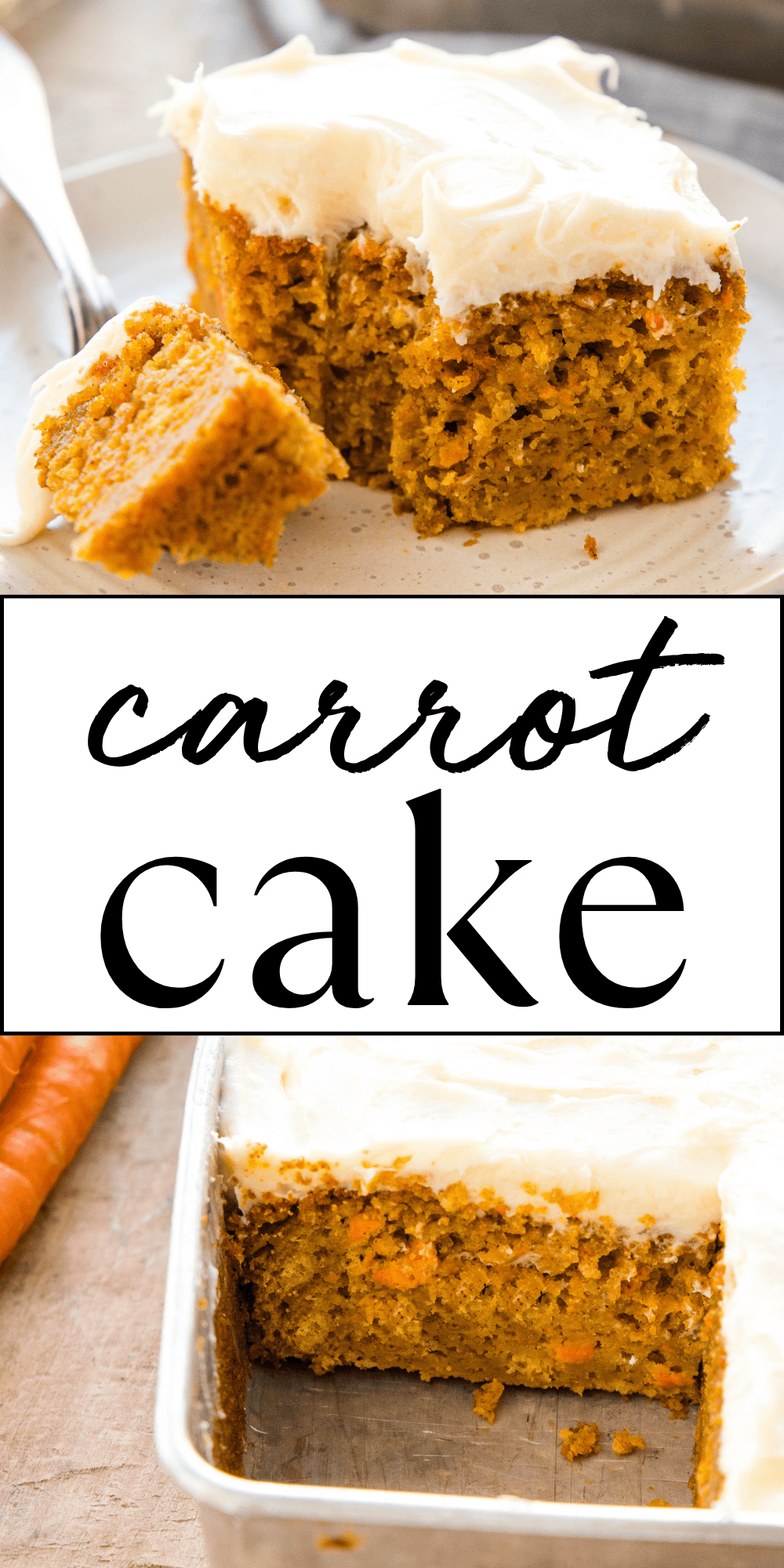This Easy Carrot Cake recipe is the perfect classic carrot cake that’s simple to make in one bowl. It’s the best carrot cake recipe for beginners with fluffy cream cheese frosting!
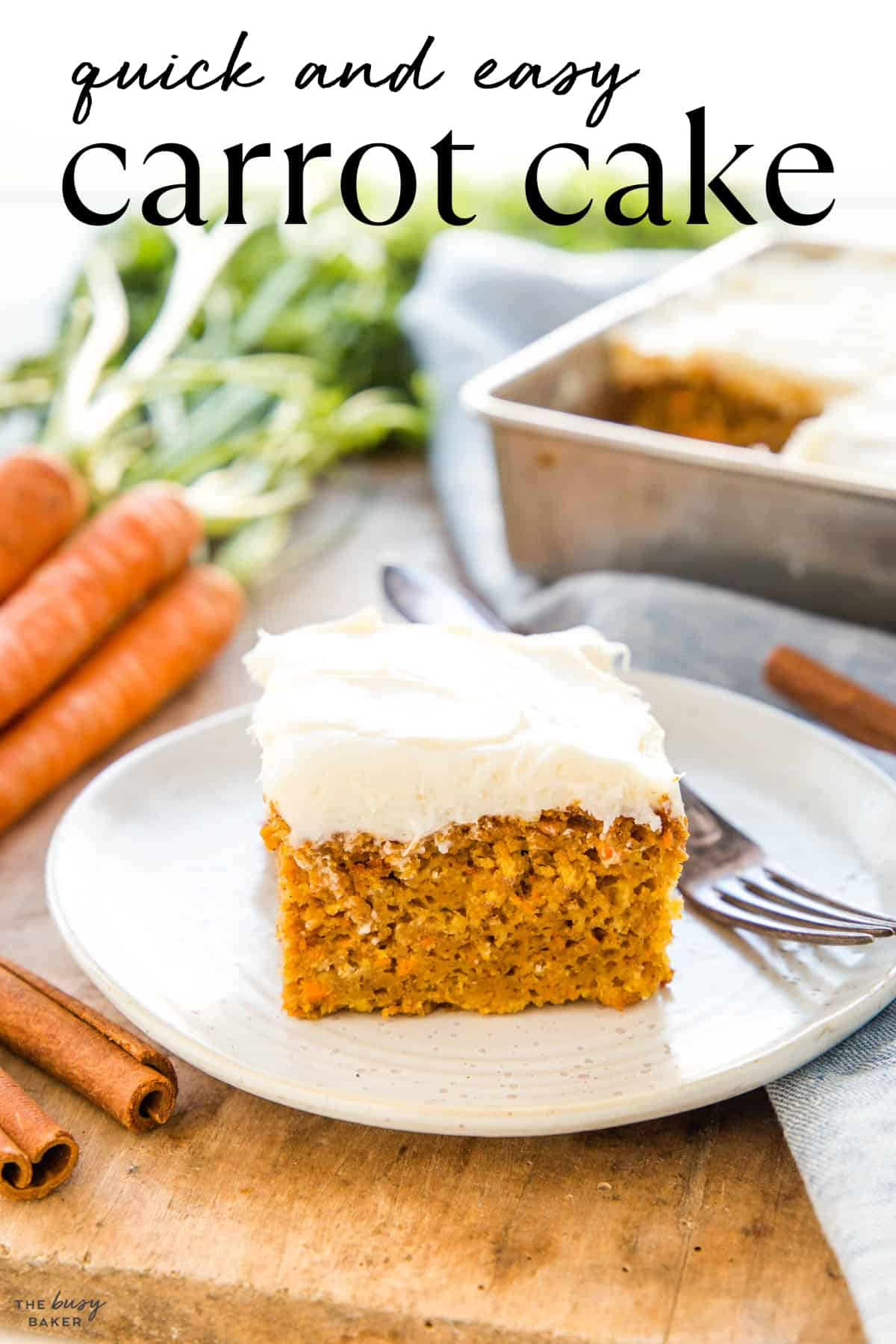
Estimated reading time: 1 minute
Carrot Cake is a beloved dessert that’s quintessentially spring. It’s a popular dessert for Easter and it’s known for its tender, moist texture and its sweetness – especially when it’s made with cream cheese frosting on top!
When it comes to baking homemade cakes, this Easy Carrot Cake recipe is the perfect one to start with – especially if you’re a beginner in the kitchen. It’s easy to make in one bowl, with basic kitchen equipment, and it’s almost impossible to mess up. Trust us, if you love carrot cake and want to make one yourself, this is the recipe for you!
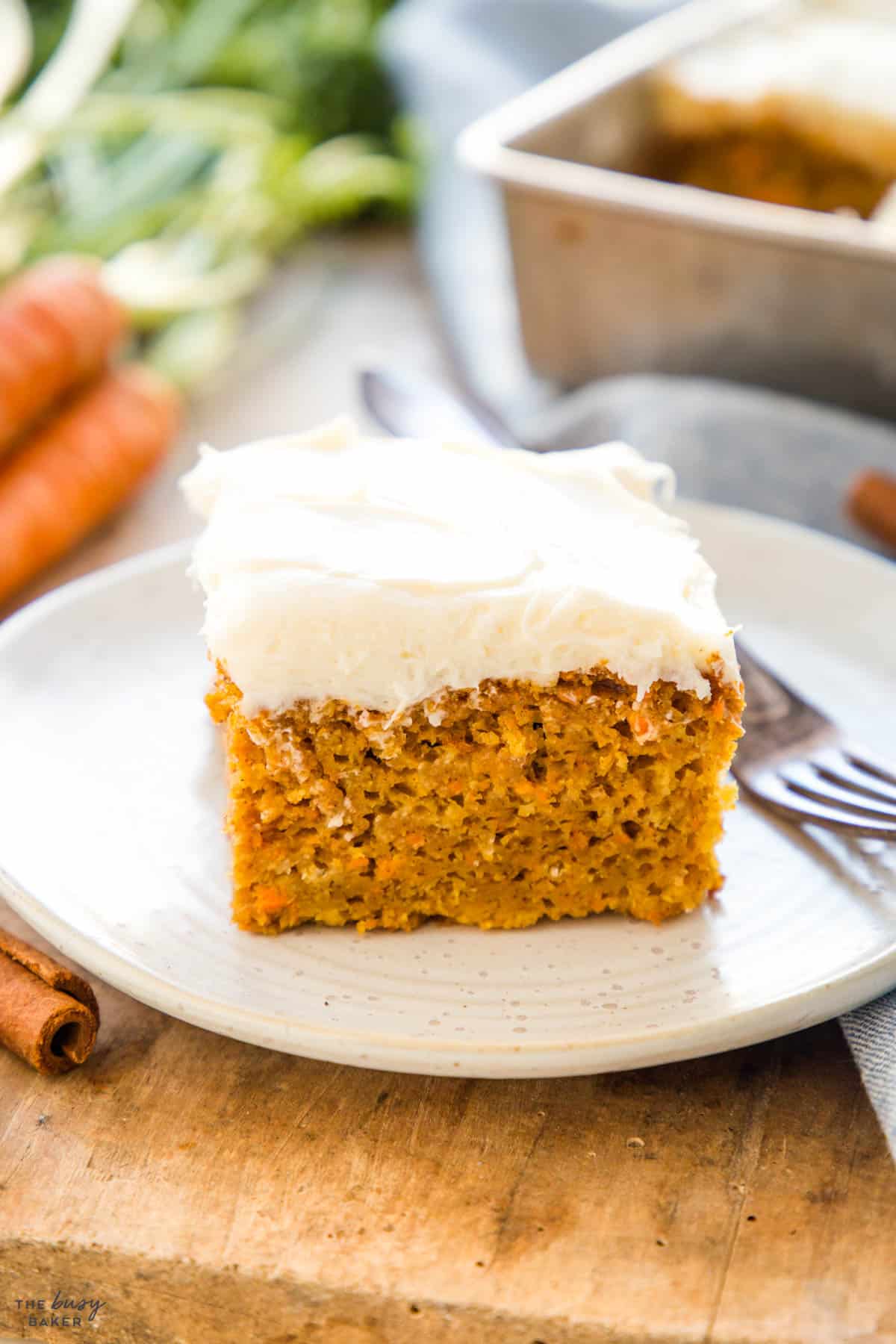
Carrot cake is a classic cake with a sweet, earthy flavour made with shredded carrots and flavoured with warm spices like cinnamon, nutmeg and cloves. It’s usually made with oil instead of butter, making it a soft, tender cake.
So many variations of carrot cake can be found in different cultures, from South America to Europe and North America. Some variations include crushed pineapple, nuts, dried fruit, and/or shredded coconut as ingredients and it’s sometime topped with a fluffy cream cheese frosting.
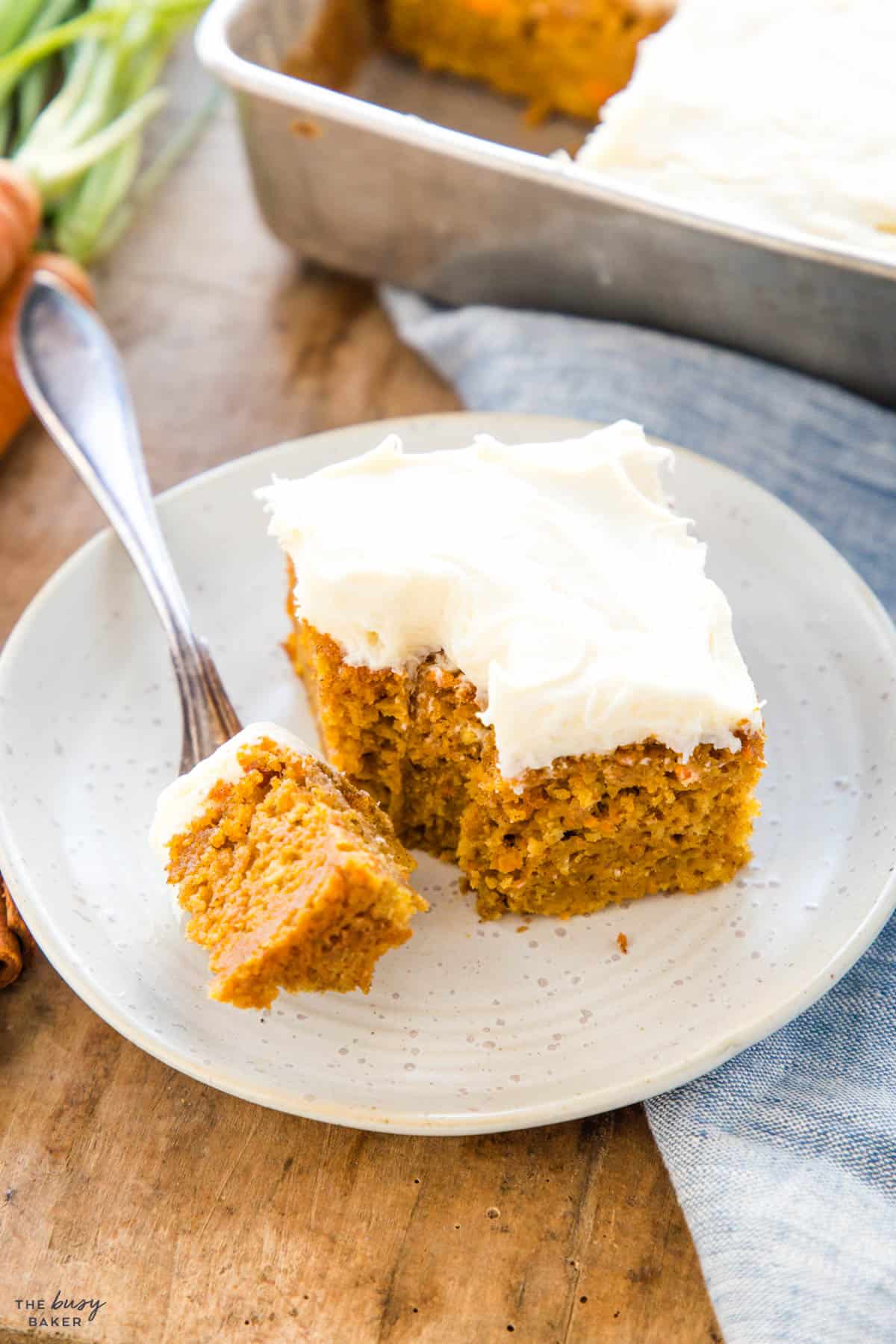
Make sure your milk and eggs are at room temperature. This will create a smooth cake batter and help the ingredients combine properly.
The best way to measure flour is in grams, but if you’re using cup measurements, be sure to fluff the flour in its bag or container before scooping VERY gently (don’t pack the flour into the measuring cup at all), then level it off with the back of a knife or other flat object.
Adding oil to the cake batter as the fat creates an ultra tender and soft cake because oil is liquid at room temperature. Melted butter could be used in place of the oil, but it makes the cake’s texture more dry and dense.
Avoid using carrots you can buy at the grocery store that are pre-grated or sliced julienne. Fresh carrots that you peel and grate yourself at home contain so much more moisture and add so much more flavour.
Do not over-mix, especially after adding the wet ingredients. Over-mixing can create a dry, tough cake.
This can create something called tunnelling where long, thin air bubbles appear in the baked cake. This is caused by vigorous mixing that strengthens the gluten strands in the cake batter too much. Instead, mix on low to medium speed just until the ingredients combine.
Always grease your cake pan generously with butter or baking spray and dust the inside with flour on all sides. This will prevent the cake from sticking to the pan. (We suggest using spring-form pans when baking round cakes for even easier removal.)
Don’t let an unbaked cake sit out on the counter. Always preheat your oven first and bake the cake immediately after adding the batter to the pans. This will help the cake rise properly in the oven as the leavening agent in the cake batter is activated as soon as the wet and dry ingredients are combined.
Don’t place the pan too close to one side of the oven as this can cause it to brown unevenly. Add the pan to the centre of the oven so it bakes evenly.
Avoid opening the oven during baking unless it’s absolutely necessary to rotate the cake while baking (if your oven is small or has a hot spot). Opening the oven door at the end of the baking time is okay, especially because testing the cake with a toothpick is necessary to prevent under or over-baking.
Over-baked cakes are dry and crumbly. Be sure to remove them from the oven as soon as a toothpick inserted into the top of the cake comes out clean.
Under-baked cakes are partly baked but gummy on top and in the centre. Test the cake with a toothpick to be sure the cake is baked completely.
Don’t try to frost a cake that’s still warm, especially if you’re using a butter-based frosting as the butter will melt and you’ll be left with a mess. Wait for the cakes to cool completely, then frost.
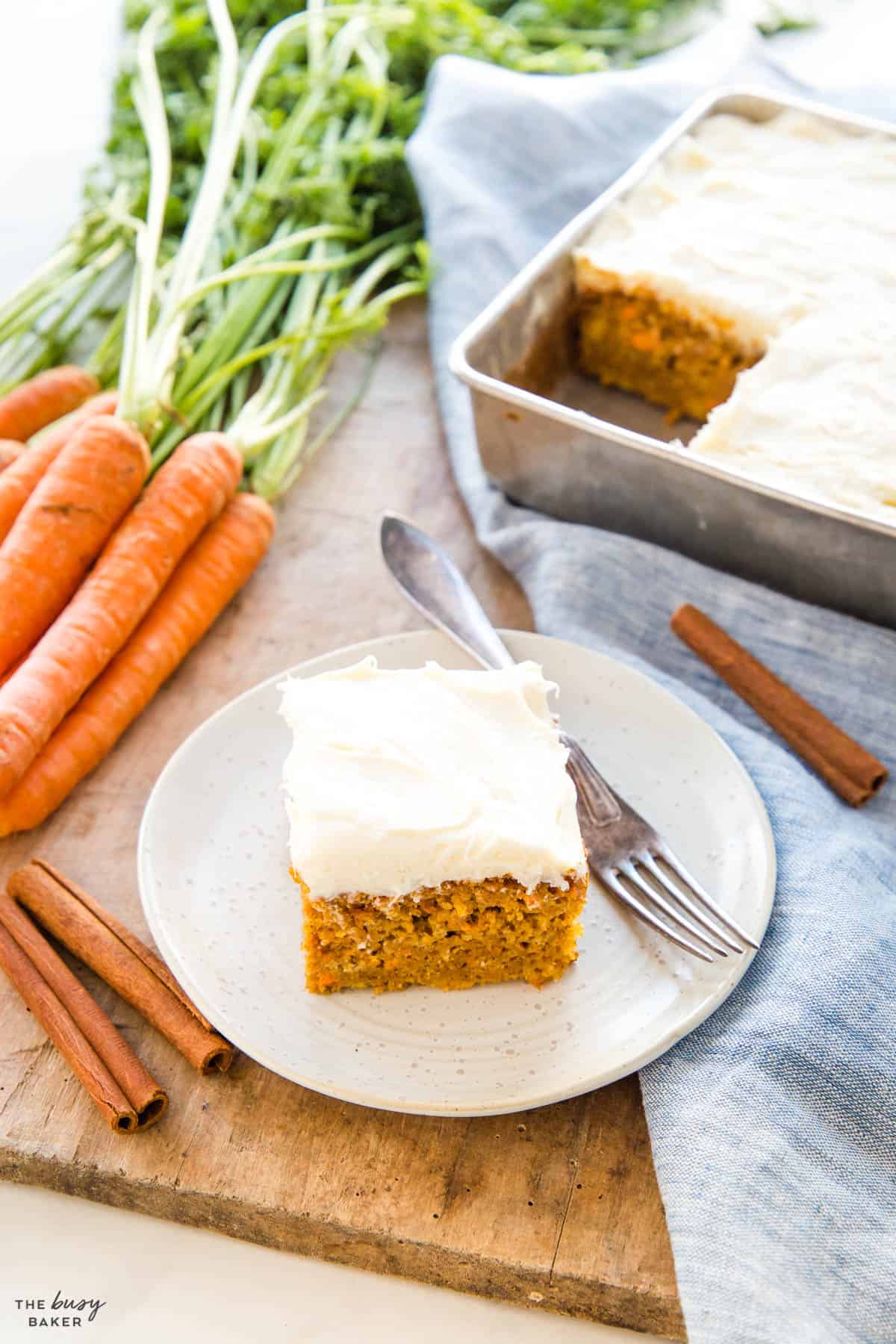
Here are some common problems you might encounter while baking cakes and how to prevent them:
- Make sure to measure ingredients accurately, especially the leavening agents like baking powder.
- Do not over-mix the batter as this can result in excess air being incorporated into the batter, leading to uneven baking and sinking in the centre of the cakes.
- Ensure the oven is preheated to the correct temperature before placing the cake inside.
- Avoid opening the oven door during baking as this can cause major changes in oven temperature and result in an uneven rise.
- Measure the flour properly by spooning it into the measuring cup and levelling it off, rather than scooping it directly from the bag (using the fluff and scoop method also works well).
- Do not over-mix the batter as this can over-develop gluten in the batter and lead to a tougher texture. Mix until the ingredients are just combined and the flour disappears.
- Check the baking time and temperature. Over-baking can cause the cake to dry out. Use a toothpick to check for doneness.
- An oven temperature that’s too high can cause the cake to rise too quickly and crack on the surface. Double-check that your oven temperature is correct by using an oven thermometer.
- Avoid opening the oven door during the first half of baking. This can cause sudden temperature changes that contribute to cracking on the top of the cake.
- Properly grease and flour the cake pans (dust with cocoa powder instead of flour for a chocolate cake). You can also use parchment paper to line the bottoms of the pans to prevent sticking.
- Allow the cake to cool in the pan for 10, 15 or even 20 minutes before inverting it onto a wire rack. Cooling the layers in the pan for several minutes helps the cake release more easily.
- Check the freshness of your baking powder or baking soda. They lose potency over time and can cause cakes to sink. Replace them if necessary.
- Ensure the oven temperature is accurate. Use an oven thermometer to check the temperature.
- Avoid over-mixing the batter, as this can deflate the air incorporated during the creaming process. Mix until just combined.
- Be sure the cakes are fully baked before removing them from the oven. If they’re not fully baked in the centre, they’ll sink in the middle after you remove them from the oven.
- Be sure the texture of your frosting is soft enough that it will easily glide over the surface of the cake without difficulty.
- It’s a good idea to refrigerate the cake layers before frosting to make frosting the cake easier (the layers will be firmer after refrigerating).
- Refrigerate the cake after frosting for about 30 minutes if the cake and frosting seem too soft. This will help both the cake and frosting firm up so it’s easier to slice.
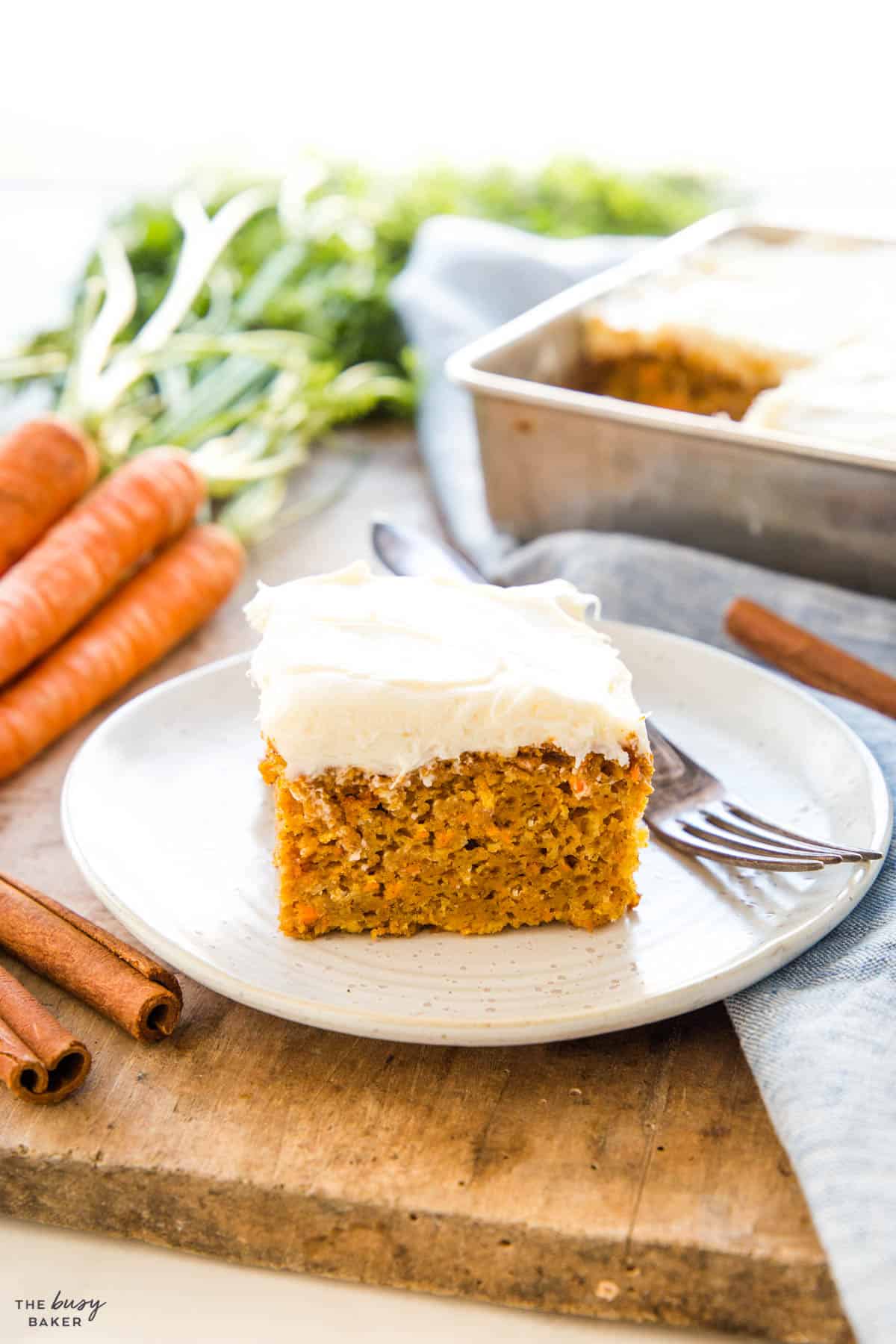
Here’s a list of the basic kitchen equipment you’ll need to make this easy carrot cake recipe (paid links):
- mixing bowls
- Grater
- measuring cups and spoons
- liquid measuring cups
- Silicone Spatula
- Whisk
- Offset Spatula
- 8-inch square baking pan (a 9-inch square baking pan also works)
- Hand Mixer
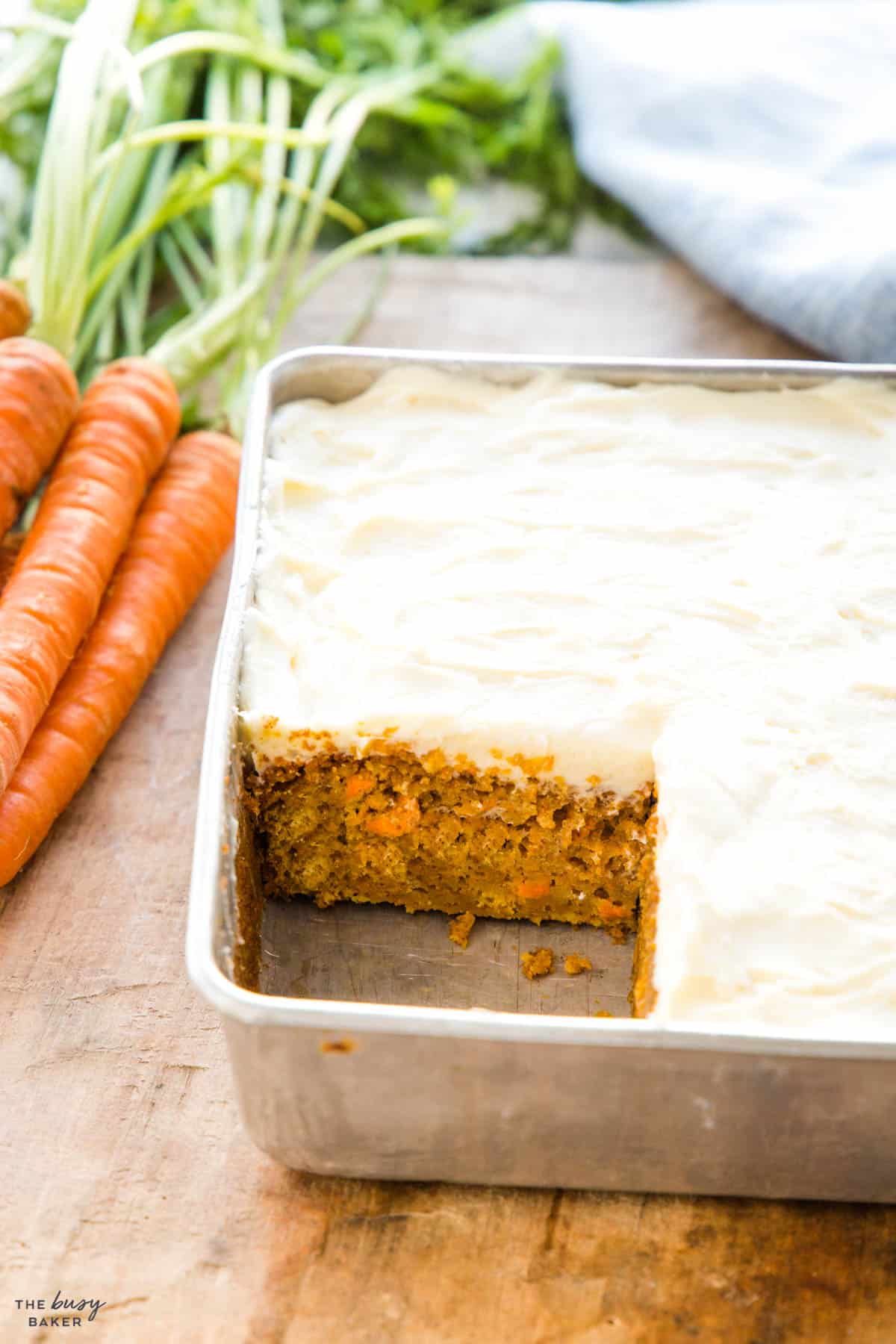
To make this carrot cake recipe you’ll need these ingredients (paid links):
FOR THE CAKE
- 1 cup all purpose flour
- 1/2 cup granulated sugar
- 1/3 cup brown sugar
- 1 teaspoon baking powder
- 1/2 teaspoon baking soda
- 1/2 teaspoon salt
- 1 teaspoon cinnamon
- 1/2 teaspoon nutmeg
- 1/4 teaspoon cloves
- 1 cup shredded carrots
- 2/3 cup buttermilk at room temperature
- 1/3 cup vegetable oil
- 2 eggs at room temperature
FOR THE FROSTING
- 1/3 cup unsalted butter at room temperature
- 1 cup powdered sugar
- 1/3 cup cream cheese cold from the fridge
- 1/2 teaspoon vanilla extract
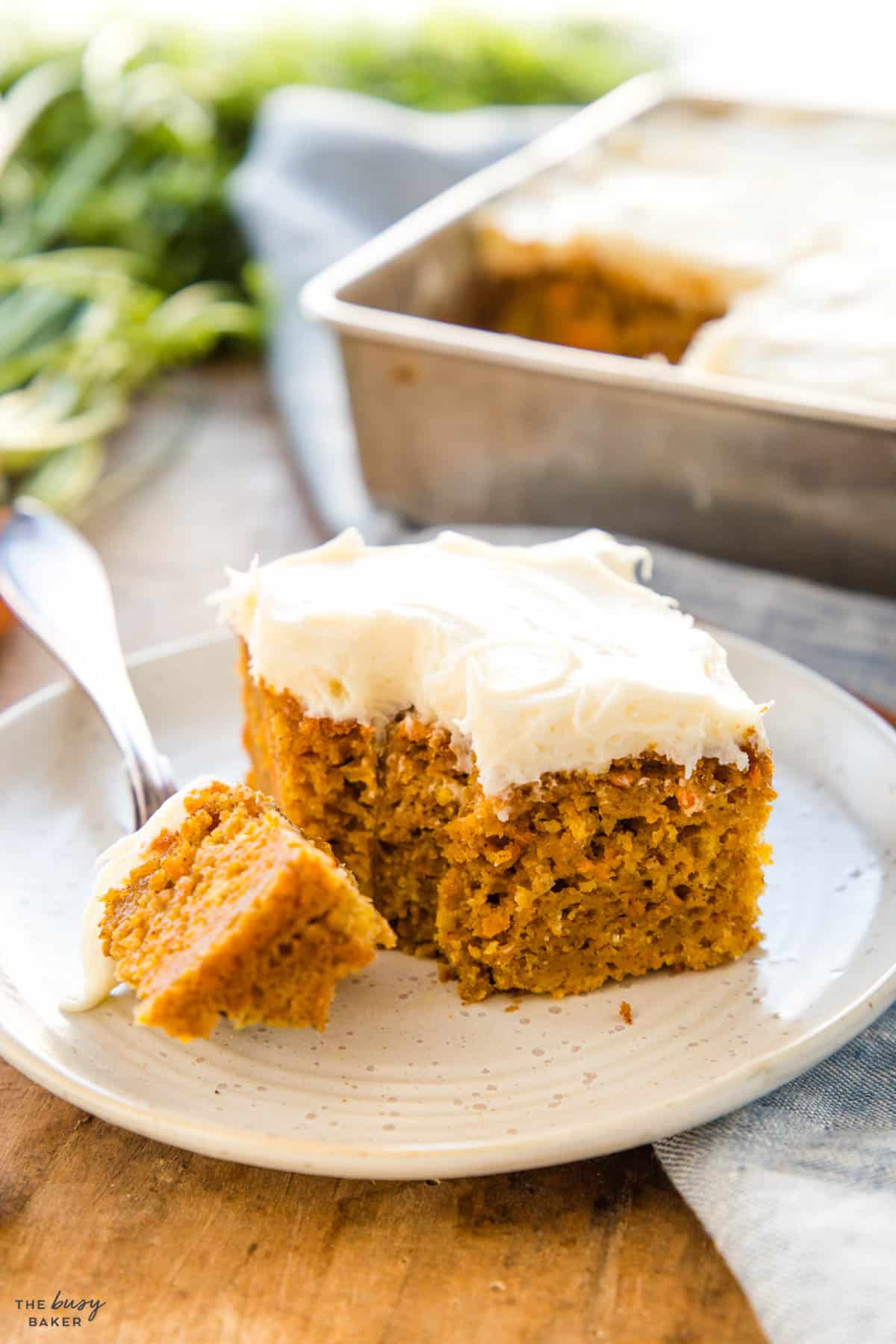
Time needed: 1 hour and 55 minutes
Follow these steps to make the best carrot cake recipe!
- Preheat your oven.
Preheat your oven to 350 degrees Fahrenheit and prepare a square cake pan (8-inch square or 9-inch square) by greasing it with butter or baking spray and lining it with parchment paper. Set it aside.
- Mix the dry ingredients.
Add the flour, sugars, baking powder, baking soda, salt, cinnamon, nutmeg and cloves to a large mixing bowl and whisk together until combined. Add the shredded carrots to the dry ingredients and mix together.
- Mix the wet ingredients.
Measure the buttermilk and oil into a liquid measuring cups and then add the eggs. Whisk them together well with a fork until combined.
- Combine the dry and wet ingredients.
Add the buttermilk mixture to the dry ingredients and mix together by hand with a silicone spatula just until the mixture is smooth and no lumps remain.
- Bake the cake.
Pour the batter into the prepared baking pan and bake for about 35-38 minutes at 350 degrees Fahrenheit. To see if the cake is done, insert a toothpick into the centre. If it comes out clean, the cake is done. Place the cake pan on a wire rack to cool completely.
- Prepare the frosting.
Add the butter to a mixing bowl and mix on high speed with a hand mixer until pale in colour (2-3 minutes). Add the powdered sugar and mix well until combined, scraping down the sides of the bowl. Add the cold cream cheese and mix well to combine, just until the mixture is creamy and smooth. Mix in the vanilla.
- Frost the cooled cake.
Be sure to frost the cake after the cake has cooled completely. Adding frosting to a hot cake will cause the frosting to melt. Add the frosting on top of the cake and use an offset spatula to push the frosting out to the edges of the cake, smoothing out the top.
- Serve and enjoy!
Slice and serve immediately or store in an airtight container in the fridge until ready to serve.
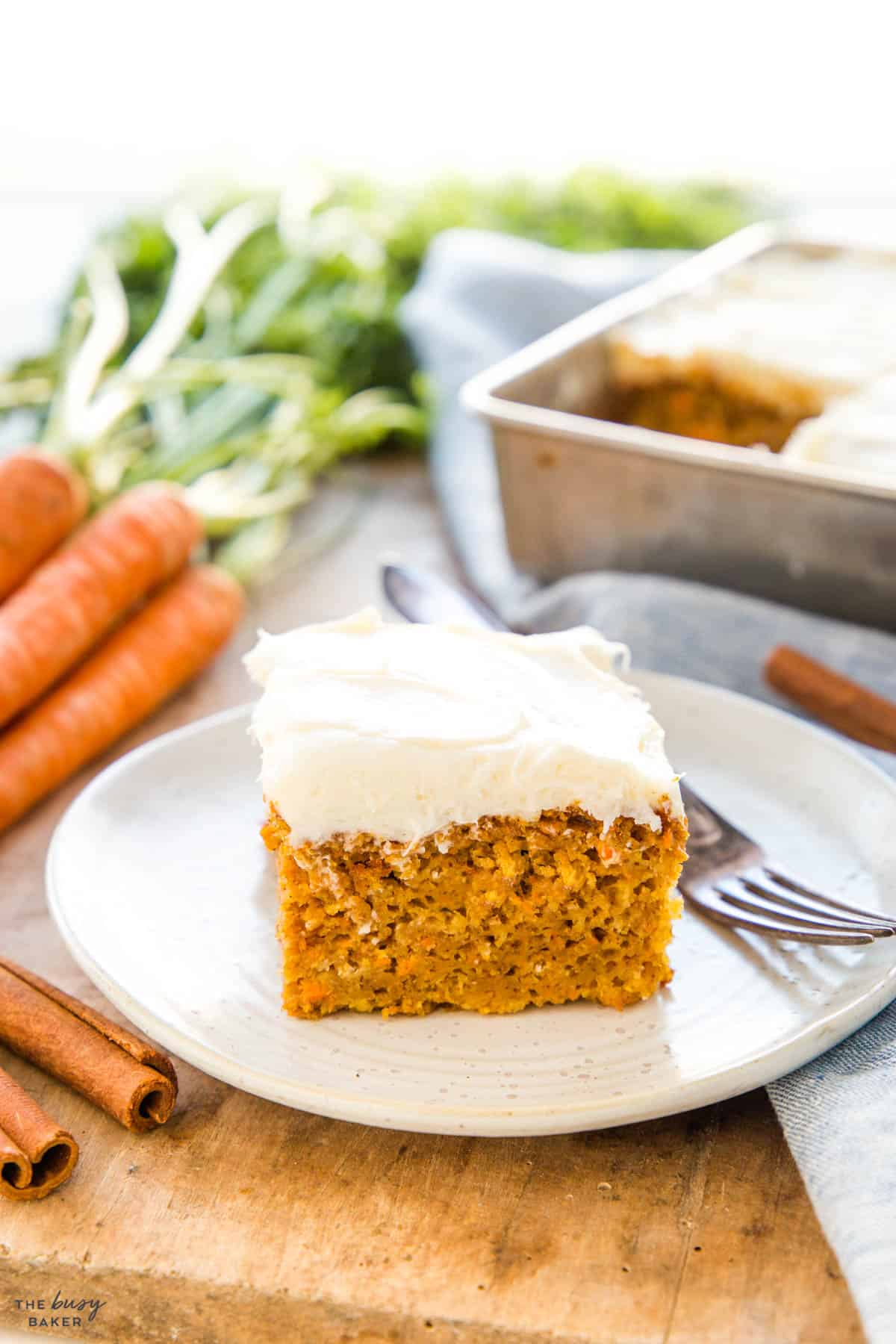
Does carrot cake actually taste like carrots?
The carrots in the cake are there to create colour and a moist texture, not necessarily flavour. The taste of carrots is extremely mild.
Why is carrot cake popular?
It’s a popular dessert because of its rich, moist texture and the tanginess of the cream cheese frosting it’s usually topped with.
Is carrot cake healthy?
Carrot cake is not necessarily healthy just because it contains carrots. It’s made with as much sugar, flour and oil as other cakes, so it’s not the healthiest choice.
Can carrot cake be made gluten-free?
Yes, feel free to use a gluten-free flour blend that performs like all purpose flour in this recipe.
How do you store carrot cake?
We recommend storing this cake in the fridge because it’s frosted with cream cheese frosting. Be sure to cover it or store it in an airtight container in the fridge for up to 3 days.
Can you freeze carrot cake?
Yes, we recommend freezing carrot cake unfrosted because the frosting loses its fluffy texture once it’s frozen and thawed. Freeze in an airtight container or bag, defrost it at room temperature, and frost before serving.
Can I add pineapple, nuts or coconut to this recipe?
You can add up to 1/2 cup shredded coconut or nuts to this recipe without it affecting the final result, however adding pineapple will influence the moisture level of the cake and affect the final result.
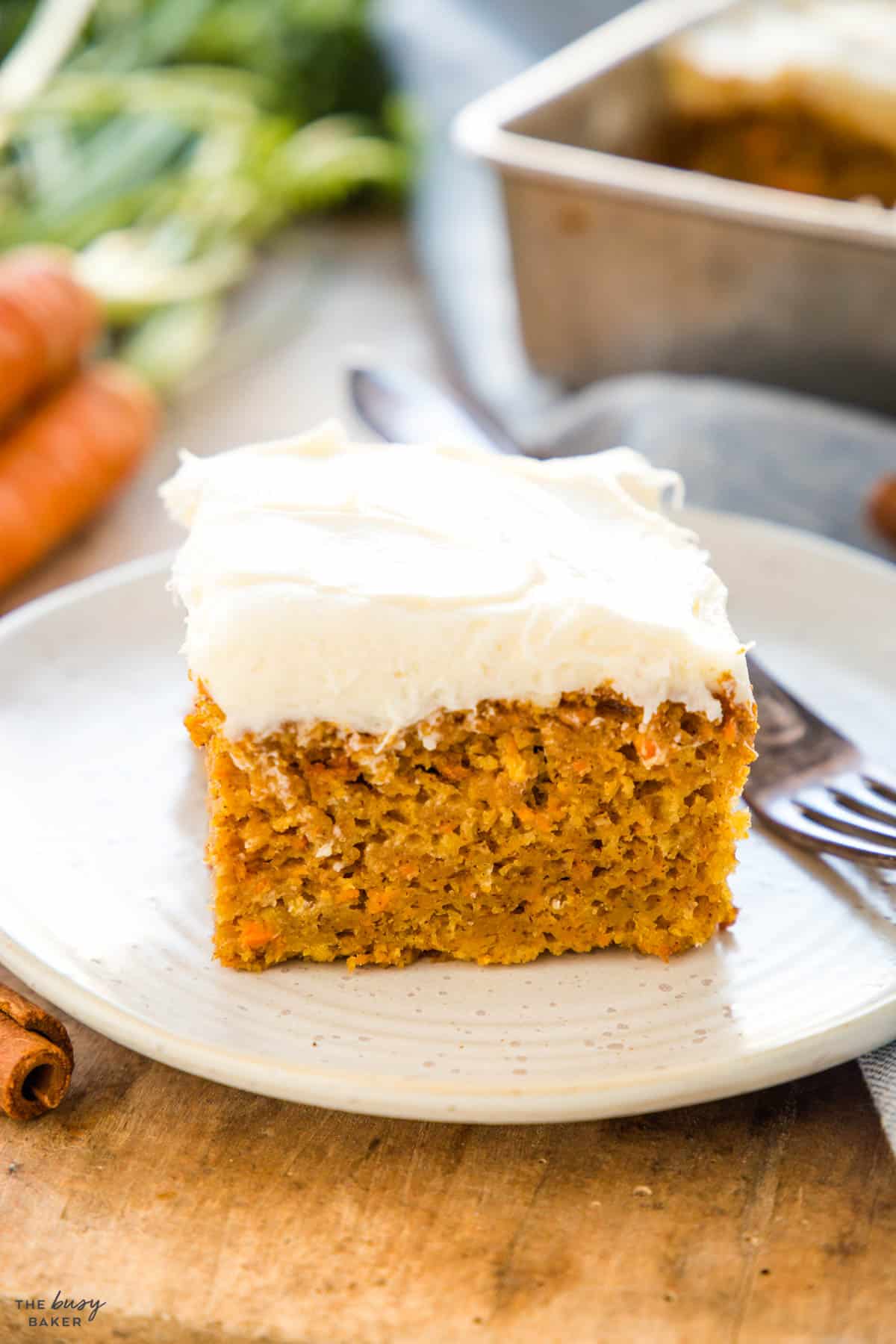
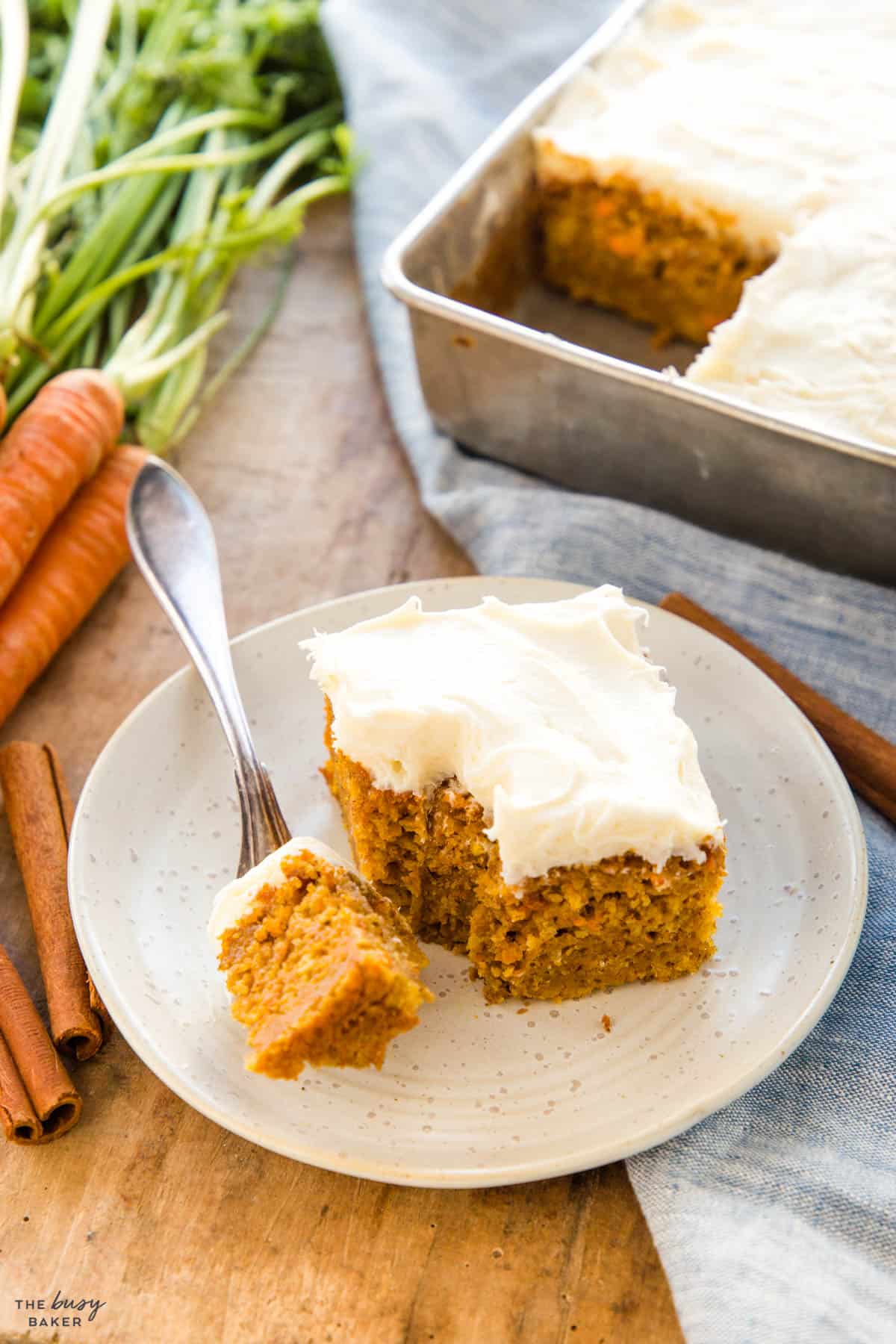
We hope you love this delicious carrot cake recipe as much as we do! Let us know in the comments below, what’s your favourite spring dessert? We’d love to know!
- Baileys Chocolate Cake
- Best Red Velvet Cake
- Berry Chantilly Cake
- Chocolate Lava Cake
- Easy Pumpkin Cake
- Zucchini Chocolate Cake
- Chocolate Layer Cake
- Lemon Blueberry Cake
- Lemon Poppy Seed Cake
- Angel Food Cake
Watch the video below to see exactly how we make this recipe. You can find many more deliciously simple recipe videos on our YouTube channel!
If you made this, share a photo!
Are you trying this recipe? Use the comment form below to share your take; now with support for image uploads and comment voting!
Easy Carrot Cake
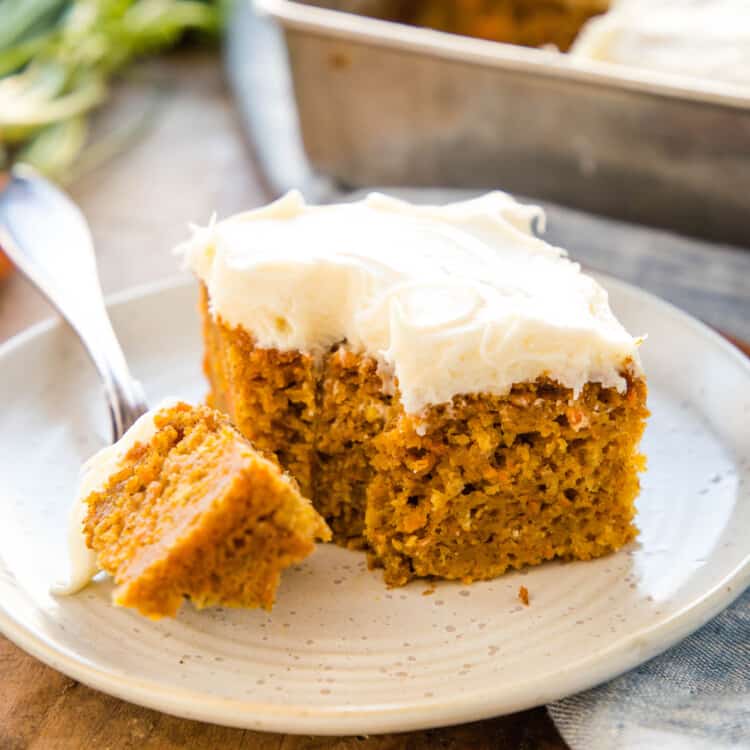
Recipe: Equipment
- 8-inch square baking pan a 9-inch square baking pan also works
Recipe: Ingredients
For the Cake
- 1 cup all purpose flour
- 1/2 cup granulated sugar
- 1/3 cup brown sugar
- 1 teaspoon baking powder
- 1/2 teaspoon baking soda
- 1/2 teaspoon salt
- 1 teaspoon cinnamon
- 1/2 teaspoon nutmeg
- 1/4 teaspoon cloves
- 1 cup shredded carrots
- 2/3 cup buttermilk at room temperature
- 1/3 cup vegetable oil
- 2 eggs at room temperature
For the Frosting
- 1/3 cup unsalted butter at room temperature
- 1 cup powdered sugar
- 1/3 cup cream cheese cold from the fridge
- 1/2 teaspoon vanilla extract
Recipe: Instructions
For the Cake
- Preheat your oven to 350 degrees Fahrenheit and prepare a square cake pan (8-inch square or 9-inch square) by greasing it with butter or baking spray and lining it with parchment paper. Set it aside.
- Add the flour, sugars, baking powder, baking soda, salt, cinnamon, nutmeg and cloves to a large mixing bowl and whisk together until combined.
- Add the shredded carrots to the dry ingredients and mix together.
- Measure the buttermilk and oil into a liquid measuring cup and then add the eggs. Whisk them together well with a fork until combined.
- Add the buttermilk mixture to the dry ingredients and mix together by hand with a silicone spatula just until the mixture is smooth and no lumps remain.
- Pour the batter into the prepared baking pan and bake for about 35-38 minutes at 350 degrees Fahrenheit. To see if the cake is done, insert a toothpick into the centre. If it comes out clean, the cake is done.
- Place the cake pan on a wire rack to cool completely.
For the Frosting
- Add the butter to a mixing bowl and mix on high speed with a hand mixer until pale in colour (2-3 minutes).
- Add the powdered sugar and mix well until combined, scraping down the sides of the bowl.
- Add the cold cream cheese and mix well to combine, just until the mixture is creamy and smooth. Mix in the vanilla.
- Be sure to frost the cake after the cake has cooled completely. Adding frosting to a hot cake will cause the frosting to melt.
- Add the frosting on top of the cake and use an offset spatula to push the frosting out to the edges of the cake, smoothing out the top.
- Slice and serve immediately or store in an airtight container in the fridge until ready to serve.
Recipe: Notes
Storage Instructions
Store this cake in an airtight container in the fridge for up to 3 days.Freezer Instructions
We recommend freezing this cake unfrosted in an airtight container or large freezer bag. Defrost at room temperature and then frost before serving. It’s possible to freeze the cake once it’s been frosted, although the frosting might change slightly in texture as it freezes and thaws.Recipe: Nutrition
Notice: Nutrition is auto-calculated, using Spoonacular, for your convenience. Where relevant, we recommend using your own nutrition calculations.
